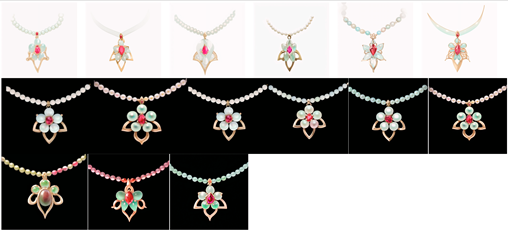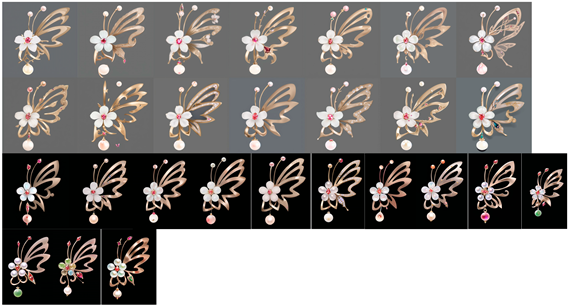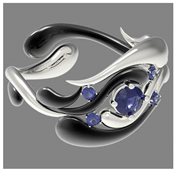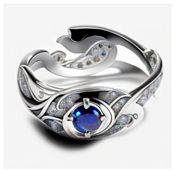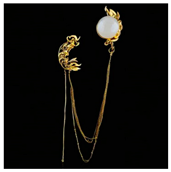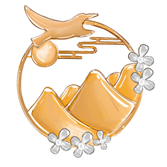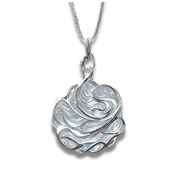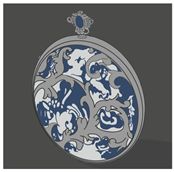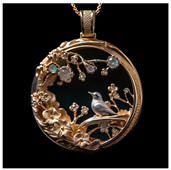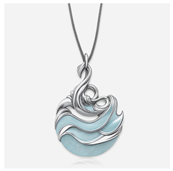Abstract
The current proliferation of artificial intelligence (AI) is prominently shaping the design industry. Generative AI, such as text-to-image and image-to-image models, has gained widespread use, notably for its efficiency and quality improvements. However, their potential to aid in cultural translation within creative design is underexplored. To address the existing gap, this study aims to assess the impact of generative AI on cultural translation within jewelry design. Specifically, a comprehensive study was conducted through a design-action experiment, collecting 46 student designers’ design-action data and self-reports, and enlisting the evaluation from 30 design experts. The findings highlight the substantial influence of generative AI on the ideation phase of jewelry design, especially in depth rather than breadth, and in the shape factor at the technical level such as detailization and unexpected composition. Leveraging AI image generators has shifted the designer’s focus from technical tasks to strategic decisions related to visual appeal, cognitive engagement, and emotional resonance. Furthermore, the challenges inherent in human–AI collaboration have been revealed, stemming from communication difficulties and the risk of fixating on specific details to stylistic constraints. Based on data analysis, a novel hybrid model regarding human–AI co-creation on cultural translation in jewelry design is proposed. Overall, this current study offers a valuable reference point to future research in terms of examining the effect of emerging technologies on cultural translation in creative fields.
1. Introduction
The process of design is characterized by its intricate and elusive nature, but creativity is manifested in the whole process, especially the early stages of design. Ideation in design, alternatively, creative idea generation, always plays a vital role in the early stages of production design. With the accelerating development of generative artificial intelligence (AI) algorithms in recent years, its application has achieved extraordinary outcomes in different fields, including the creative design []. To date, designers can harness and interact with various text-to-image or image-to-image Al models (e.g., Midjourney [], Stable Diffusion [], OpenAI’s DALL-E 2 [], and Deep Dream Generator []), which could facilitate in augmenting creativity and stimulating visual imagination and ideation [,].
Jewelry, being a highly personalized and swiftly iterative product category, necessitates a multitude of creative concepts to flourish, thus rendering it a pivotal domain suitable for the implementation of AI. It is essential to recognize that this specific product category transcends mere adornment and extends to encapsulate emotions and attitudes []. As Hong Kong jewelry designer Dickson Yewn stated, jewelry is “the new way to interpret a culture” []. Social progress and cultural development have an obvious influence on the forms, functions, and meanings of jewelry designs []. Cultural sustainability indicates the capacity to maintain and perpetuate cultural beliefs, practices, and heritage, while also ensuring the continuation of culture in the future []. Within the realm of design, cultural value can be embedded in products through creative design, which involves integrating cultural elements into new artistic forms to pass on multiple cultures to consumers and activate the cultural value [,]. However, the potential of human–AI collaboration in setting cultural translation as a design goal has not yet received wide attention.
To fill the identified research gap, this study aims to investigate and examine how generative AI technology can affect culture translation in the jewelry design process, the designers’ mindsets, and the outcomes. To achieve the research purpose, the following three research questions (RQs) were proposed:
RQ1: How can generative AI affect culture translation in the jewelry design process during the early stages of ideation?
RQ2: How effective is generative AI in augmenting the design ideation during cultural translation?
RQ3: What are the typical challenges in the human–AI collaboration?
An experimental study was performed, including 46 jewelry designers tasked with executing two design assignments inspired by Chinese aesthetics. The first task involved employing conventional design techniques, while the second task necessitated the use of AI-generated images to stimulate the ideation process. Data collection encompassed three primary sources, namely, design activity records, designers’ self-reported insights, and evaluations from expert design assessors. According to the data analysis results, a model of human–AI co-creation for culture translation in jewelry design was put forward, which is conducive to providing a new reference for cultural sustainability in the era of artificial intelligence.
Figure 1 reveals that this study can be divided into three parts. In the first part, a literature review was performed to explore the research framework for the impact of generative AI on cultural translation in jewelry design. In the second part, 52 designers were invited to create following the ideation task. The third section describes self-reported data from designers, design outcomes, and evaluation results from experts, which were collected for analysis and discussion. Finally, the conclusions of this study are provided.

Figure 1.
The procedures used in this study.
2. Literature Review
The literature review consists of three parts that support AI-augmentation research on the creative process of cultural translation in jewelry design, including computer-aided design, the activities in human–AI collaboration, and cultural translation in jewelry design.
2.1. Computer-Aided Design
Technology is of great importance in the design process, providing designers with a series of computer-aided design (CAD) tools, including graphic software, 3D modeling software, and digital rendering platforms. The CAD for concept generation can be categorized into three types according to their potential roles in the human–computer collaborative relationship: guide, stimulation, and generation []. The methods to guide are instructively involved in the generation of design concepts, which aim to provide design rules or guidelines for the activities of the designers, such as team-based brainstorming and mind mapping. Stimulation refers to knowledge-based methods and visual stimuli like images and sketches, which can influence design performance []. Generation denotes that designers can use various software to draw sketches, pictures, or three-dimensional prototypes, which is a crucial step in shaping creativity and can help designers further communicate and evaluate ideas [].
With the rapid advancement in generative AI technology in recent years, more intelligent new design tools and functions are emerging, which then integrate a series of generative AI models such as generative pre-trained transformers (GPTs), generative deep models (GDMs), and generative adversarial networks (GANs) [,]. These have received increasing interest from the design community, including the field of jewelry design. Generative AI tools represented by Midjourney [] and Stable Diffusion [] can help designers quickly complete designs with high accuracy and repeatability. They use prompts as inputs combined with image generation algorithms with large language models to facilitate text-guided image generation. The basic logic is to combine or merge a large number of ideas to produce much stronger ones [].
Additionally, increasing studies concentrate on the challenges and opportunities of human–AI collaboration in diverse contexts [,,]. Based on some empirical studies, the AI agent assists designers in diversifying their solutions to fulfill the design objectives and presents great potential to guide more explorative design strategies [,]. However, in terms of generative AI, there is a great limitation that they are currently only capable of learning and generating spatially visualized representations of design concepts based on training data sets, which are mainly helpful for detail design and may cause design fixation if applied in earlier stages [].
Although CAD has been widely used in jewelry design to improve efficiency, the current system focuses more on quick modeling (e.g., Rhinoceros 3D, Blender, ZBrush). There were few tools to assist in generating conceptual design before the emergence of generative AI. An earlier AI-design practice named “the chair project”, took generative adversarial neural networks (GANs) as automatisms to stimulate the imagination of human designers []. Limited by the washout problem of GANs, generative images still need designers to handle most visualization tasks and to add details based on design principles and creativity. The latest applications of AI are to generate visual images from natural language descriptions and initial image guides, which can create thousands of higher-quality images with minimal effort [].
The use of new technology forces designers to broaden their understanding of the design process and adapt their methods, ultimately leading to the potential generation of innovative products [,]. A novel form of production is based on past models but only comes into being in response to individual demand. Therefore, the advantages and design limitations brought by AI technology make human–computer interaction more complex. While there is methodological readiness for designing with CAD, the nuances of human–AI collaboration need to be further explored from the perspective of the workflow in generative AI-augmented design creativity (Figure 2). The mapping from potential ideas to specific elements is closely associated with the experience and knowledge of the creator []. After the translation from inputted elements such as images or text description, the AI model handles the next stage to decoding, latent diffusion, and encoding in the pixel space to generate numerous new related images. Both training data sets and parameter settings influence the outputs. Moreover, it may bring positive value, such as guidance, stimulation, and generation, while also having an impact on design fixation.
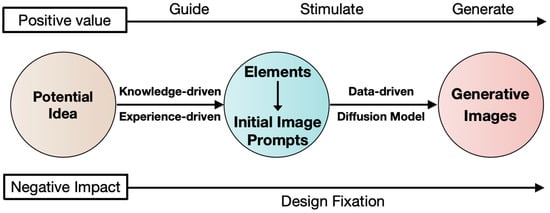
Figure 2.
The workflow in generative AI-augmented design creativity.
2.2. Activities in Human–AI Collaboration
In Cross’s earlier studies, he found that seemingly, the only ”positive” effect of CAD was to speed up the design process, while reducing the person-power required in the team []. However, he believed human–machine interaction would efficiently produce design solutions better than that which a human or a machine could produce alone. To find the answer to whether the machine can design, it is necessary to analyze the design activities of people []. Unlike conventional liner technology that achieves one outcome based on one action, AI poses challenges to the creative process and workflow, characterized by its learning pattern and random generation []. Computer design research informs us concerning designers’ thinking []. Facing infinite and limitless sources of information, requirements, wants and needs, limitations, and opportunities, the designer has to make all kinds of decisions and judgments []. Numerous studies on design practice have indicated that designers who can handle complex design situations successfully use design thinking and activities [,]. The utilization of emerging technologies stimulates designers to expand their understanding of the design process and alter their design methods, which in turn has potentially generated new products []. Moreover, incorporating AI into products, services, and systems is complex, requiring the attention of the design discipline, and the initial answers might be hidden in the design cognition [].
The design process involves a continuous series of decision-making activities that collectively shape a final outcome []. Design as research is an approach that combines the principles of design and research methodologies to address complex problems and generate new knowledge. It involves using design processes and methods to investigate, explore, and understand problems, as well as to propose and test potential solutions [,]. Designing is intimately tied to new technologies that generate a complex set of decision points for designers. The changes, problems, and solutions of traditional design influenced by technology can be explored from the design process [,]. In collaboration with generative AI tools, the activities, such as what prompts should be inputs and which images can be chosen to further update, are usually driven by decisions. Then, decision-making is also influenced by experience, knowledge, and preferences. Visual stimulation can assist the perception and interpretation of more ephemeral phenomena by color, texture, form, images, and status []. Iteration is considered an integral part of design activity that may be classified as the diagnostic and transformative process [,]. Adams and Atman empirically explored the iteration behavior in the design process, recognizing that compared to beginners in design, senior designers iterate more times and more effectively []. Focusing on the impact of AI on design iteration, Zhou et al. conducted a graphic design experiment and results indicate AI augmentation increases the frequency of cognitive activities during iteration []. Actually, the activities of human–AI collaboration encompass a complex cyclical process, as shown in Figure 3.
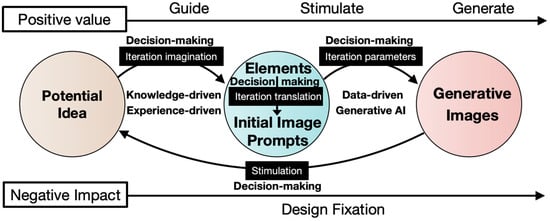
Figure 3.
The workflow of generative AI-aided design creativity.
2.3. Cultural Translation in Jewelry Design
Currently, more attention is given to the role and importance of culture in sustainable development. Cultural features are considered unique features that can be embedded in products to achieve sustainable cultural spread and value transformation [,]. Therefore, it is crucial to confirm the methods for integrating cultural elements into creative product design. Based on previous research, the factors that affect cultural and creative product design include aesthetics, creativity, practicality, and commercial value, which are taken into consideration [,]. Lee [] introduced the term “cultural variable”, which means to profile cultural characteristics and identify the key design attributes, such as functional, aesthetic, and symbolic ones. There, cultural objects can be incorporated into cultural design. Lin [] identified three design features: inner-level (e.g., stories, emotions, and cultural features), mid-level (e.g., function, operational concerns, usability, and safety), and outer-level (e.g., color, texture, form, decoration, surface pattern, line quality, and detail). To bridge the implicit layer of culture and an explicit layer of design characteristics, a series of culture-embedded product design models were proposed and developed from the perspective of communication [,,], which divided the design and perceptual process of the product into the technical level, semantic level, and effectiveness level. The technical level requires attracting the users through cultural features through their senses; the semantic level focuses on precisely transmitting cultural information; and the effectiveness level concerns the emotional connection and reflection.
Traditional jewelry design is time-consuming and labor-intensive. It requires a high level of drafting skills. Furthermore, the unique jewelry design can be created by harnessing different pattern combinations in varying proportions, but it leads to a very tedious design process []. While several designers have embraced traditional Chinese elements such as dragons, the phoenix, bamboo, and Chinese characters into their products, they occasionally do not apply or combine them properly, making them become less meaningful []. On the contrary, appropriate combinations of elements can accurately convey cultural information. Designers pass the new concept into the jewelry through the material, color, craft technique, etc., which causes the wearer’s spiritual resonance []. From the coding perspective of jewelry design, the external features of design include shape, craftsmanship, and materials. The combination of these features also carries cultural metaphors, ultimately conveying a sense of ritual and pleasure [,], as displayed in Figure 4.
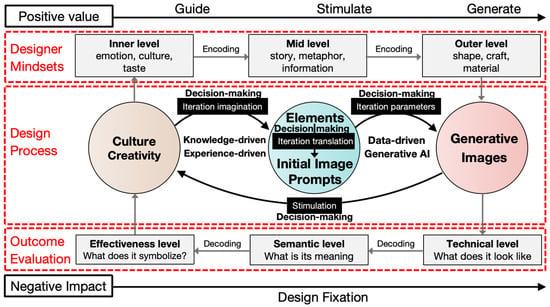
Figure 4.
The research framework for the impact of generative AI on cultural translation in jewelry design.
The development of technology could indeed have an impact on the actions of design creativity, both positively and negatively. Especially in the collaborative creation process between humans and generative AI technology, the path in design thinking shows new features. Despite powerful AI methods becoming increasingly accessible for creative design, we still know relatively little about how to translate cultural features in collaboration with AI-powered image generation systems. Culture and creative designing are, after all, a form of designing. The discussion about the impact of generative AI on the ideation process must be firmly based on the model of conventional design. Therefore, this article is concerned with the impact of generative AI technology on the ideation of embedded culture features in jewelry design and explores the positive and negative effects of technology on design thinking from a cultural perspective.
2.4. Research Framework
According to this literature review and the purpose of the study, a research framework is proposed, as displayed in Figure 4. In the encoding process of incorporating cultural features into jewelry design, it includes first encoding from the inner-level (e.g., emotion, culture, taste) to the mid-level (e.g., story, metaphor, information), and second encoding from the description of meaning to the outer-level (e.g., shape, craft, material). The outputs serve as stimuli to trigger the designer’s decision-making during iterative behavior toward description and parameters. Viewing image stimulation as a decoding process involves bottom-up evaluation at the technical levels (i.e., what does it symbolize?), semantic level (i.e., what is its meaning?), and effectiveness level (i.e., what does it look like?). In the action analysis of new technology-assisted ideation, attention needs to be given to the empowerment in guidance, stimulation, and generation, together with the design fixation on thinking and decision-making.
3. Methods
3.1. Participants
This study was conducted as a class exercise in a jewelry design class at Shenzhen University of Technology. Totally, 52 senior undergraduate students (S1–S52) volunteered for the experiment. All of these participants were industrial design students. As a prerequisite, they are already proficient in using a series of generative AI tools, such as Midjourney, Stable Diffusion, and Deep Dream Generator. Both Midjourney and Deep Dream Generator are online platforms that allow users to create images using deep learning algorithms, paid by a charge that is based on the number of images or usage time. Stable Diffusion is operated by most users on Google Colab (https://github.com/AUTOMATIC1111/stable-diffusion-webui, accessed on 25 April 2023), which renders additional higher learning costs, more control freedom, and lower operation expenses. Due to the consideration of originality in the design, participants were encouraged to update the design concept by using the initial image, perhaps combined with prompts. Based on the output results, there were six participants (S4, S7, S15, S24, S47, S52) who did not meet the experimental requirements; their data were excluded. Therefore, the final analysis data came from 46 participants.
3.2. Experimental Procedure
Initially, the participants were asked to complete, using a traditional design approach and within one week, a concept design task for a set of jewelry designs with embedded Chinese cultural features. During that process, conceptualization, sketching, refinement, and 3D modeling are normally involved. Then, they were tasked to collaborate with a familiar AI tool to explore Chinese-style jewelry within another week. All participants worked individually and spent a variable amount of time. They were encouraged to keep all the outputs labeled with a concise description of the different components of their ideas and document their thoughts and comments as they developed their concepts. Finally, all the outputs with notes in the ideation process and final concept design (i.e., one individual design and one collaborative design with AI) were collected, after which they self-evaluated the effect of AI in culture translation by filling in the questionnaire with nine questions corresponding to the matrix of the three translation levels (i.e., technical level, semantic level, and effectiveness level) and three jewelry design attributes (i.e., shape, craft, and material). The web-based questionnaire was designed using Qualtrics, and each item was assessed using a 7-point Likert scale with 1 indicating very low and 7 indicating very high (as shown in Part_01 of Appendix A). Moreover, a semi-structured one-on-one interview based on the matrix was carried out (as shown in Part_02 of Appendix A). During the evaluation stage, thirty jewelry design educators and experts were invited to measure the concept designs with and without AI using a 7-point Likert scale from the technical, semantic, and effectiveness levels (as shown in Part_03 of Appendix A).
3.3. Analytical Methods
Firstly, the images generated during the process were collected and compiled into tables, such as Table 1. Concept images were classified based on direction, and the numbers were counted. One-way ANOVA was adapted to test whether the impact of the generative AI was significant (the significance level was set at 0.05) for the design activity. The notes marked during the design process were integrated to explore the main action stimulated by technology.

Table 1.
Sample list of design activity data from one of participants (ID S43).
Secondly, the questionnaire data from participants’ self-assessments was statistically analyzed. Two-way ANOVA was performed to examine the effects of the three cultural translation levels (i.e., technical level, semantic level, and effectiveness level) and three jewelry design attributes (i.e., shape, craft, material) as two independent variables on the dependent variable of AI-augmented feeling. Based on the matrix structure, interview data were summarized for further discussion.
Finally, based on evaluation data from thirty experts, descriptive statistics were used to evaluate and compare design outputs generated with AI and without AI. Then, the relationship between the two types of concept design was analyzed.
4. Results
4.1. Result of Stimulation to Design Actions
Based on the encoding of the transition behaviors, descriptive statistics, and paired samples, a t-test was made to analyze the designers’ activities, including the number of image outputs and the number of directions during the ideation. According to the results shown in Table 2, AI augmentation improves the frequency of exploration action to a great extent (t (45) = 7.598, p < 0.001), which demonstrates there are significant differences in image outputs between the regular design process and the AI-assisted design process. The designer iterated more images with the assistance of AI tools. Apart from that, the square deviation up to 42.71 in the type of AI augmentation indicates a huge difference between individuals, with a maximum of 198 images. For the design direction, there also is a significant difference in the number of directions (t (45) = 2.202, p < 0.05), which denotes that AI can stimulate the further expansion of imagination, and potentially generate new products [].

Table 2.
Descriptive statistics and T-test analysis results from participant self-evaluation.
The participants actually used one or two AI tools, with most adopting Midjourney, reaching 32 people, Stable Diffusion being 14 people, and Deep Dream Generator being 11 people. From the number of images generated, it can be seen that the average number of images generated by designers using only Midjourney is 43.55 while using only Stable Diffusion generated an average of 103.78 images. It is suggested that easier operations can attract selection by more people, while more control freedom and lower cost will encourage users to make more iterative actions.
By further sorting the notes and self-reports from designers about their feelings concerning collaboration with AI, as shown in Table 3, the stimulation mainly focuses on the exploration at the technical level, such as material combination, layout possibility, and craft expressions. Furthermore, there was an increase in decision-making actions at the technical, semantic, and effectiveness levels. For the decreased activities, a series of work on the technical level is obvious. Compared to traditional design processes, the efficiency of generating high-quality image outputs of AI effectively stimulates designers to explore more possibilities, but it also brings more decision-making burdens.

Table 3.
Changes in jewelry design actions for embedded culture.
4.2. Experience of Designers Collaborating in AI Augmentation
The data from the questionnaire for designers were collected and analyzed. From the perspective of user experience, the three cultural translation levels and the three jewelry design attributes were analyzed using two-way ANOVA. The results indicate that both the “cultural translation levels” and “jewelry design attributes” have a significant interactive relationship, as shown in Figure 5. Therefore, further one-way ANOVA was performed on each factor.

Figure 5.
Comparison of the mean score for “cultural translation levels” and “jewelry encoding types”.
There are significant differences in the cultural translation levels (F (4, 413) = 29.681, p < 0.001). It can be observed from the specific comparison differences that the score for the technical level is significantly higher than that for the effectiveness level, and the effectiveness level is also significantly higher than the semantic level. As for the jewelry encoding types, there is also a significant difference in the experience of collaborating with AI (F (4, 413) = 9.000, p < 0.001). The value of AI for shape is obviously higher than that for craft and material.
Concerning the feedback from interviews, the data were classified according to the matrix by three cultural translation levels and three jewelry encoding types, as shown in Table 4. In addition, the result also reflects the designers’ experience in the added value of AI in terms of shape and technical level. However, there are more negative experiences in the creative aspects of craft and material, along with less accurate transmission of cultural semantics. The reason may be that both Midjourney and Stable Diffusion belong to the universal AI generative models and are not very suitable for application to highly specialized jewelry crafts and materials.

Table 4.
Categories of feedback for AI-empowered ideation.
4.3. Evaluation of the Outputs
After collecting the best conceptual design and AI-augmentation design from each designer, they were evaluated by 30 experts in terms of technical level, semantic level, and effectiveness level. T-test was adapted to test whether AI technology had an impact on all three levels of evaluation indicators. The result, as shown in Table 5, shows that AI-augmentation design outputs have higher evaluation scores than regular design at all three levels.

Table 5.
Descriptive statistics and T-test analysis results for expert evaluation.
To further analyze the distribution characteristics in AI-added value, the regular design scores for 46 designers were arranged in ascending order, and the corresponding AI-augmented design scores are displayed to compare the differences, as shown in Figure 6, Figure 7 and Figure 8. As presented in Figure 6, AI technology fluctuates at a certain stable level in terms of shape, craft, and material, thus significantly improving conceptual designs that were initially weak at this level. In Figure 7 and Figure 8, there are similar trends, indicating that the regular designs with low-scoring grades can be enhanced at the semantic and effective levels under the empowerment of AI. However, regular designs with high-scoring grades were not improved by utilizing AI technology.
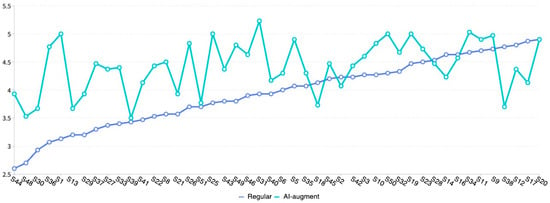
Figure 6.
Comparison of the score between regular design and AI-augmented design at the technical level.
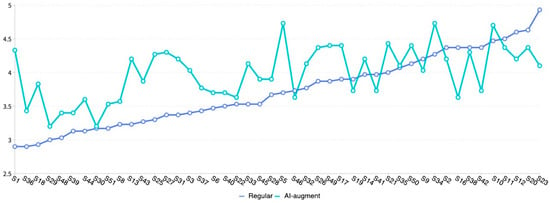
Figure 7.
Comparison of the score between regular design and AI-augmented design at the semantic level.
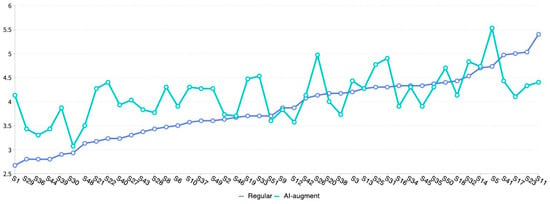
Figure 8.
Comparison of the score between regular design and AI-augmented design at the effectiveness level.
In Table 6, the regular designs with the highest scores at three levels and their corresponding AI-augmented designs are listed (i.e., S20, S23, S11), while the AI-augmented designs with the highest scores and their corresponding regular designs are also displayed (i.e., S31, S34, S5) for comparison. As the conceptual design S20, the interweaving of the two materials is very vivid, but after AI iteration, the smooth shape and clever structure disappeared. The interpretation of Tai Chi’s meaning highlights the accurate symbol representation in the regular work S23. Unfortunately, the AI system cannot decode Tai Chi culture and encode corresponding symbol graphics, which deviates from the precise transmission of semantics. As the regular design with the highest score on effectiveness level, the cultural scenario translated through traditional elements and the story of “Chang’s running to the moon” (Chinese mythology) provides a good emotional experience. Compared with human intelligence, AI cannot understand and reproduce this scenario thus far. The value of AI can be better reflected by adding details of shape, diverse craft, and materials on the technical level, including S31. In the imagination of the regular design S34, the addition of porcelain materials interprets the meaning of Taoist culture. Under the comprehensive effect of blue and white porcelain material, elegant shape, and traditional craft, the AI-augmented work S5 achieved the best cultural experience. Evidently, for regular designs with lower scoring grades, AI can provide more in-depth detail shaping and divergent styling. However, for regular designs that garnered high-scoring grades, little or negative enhancement has been revealed in the collaboration with AI.

Table 6.
List of high-scoring regular designs and AI-augmented designs.
5. Findings and Discussions
5.1. Influence of AI Augmentation on Culture Translation in Jewelry Design
Concerning the ideation process, the distribution of design actions has changed, mainly at the technical level. Benefiting from the efficient image generation of AI technology, there was a significant reduction in depth actions, such as detail characterization and adjustment actions, like style uniformity. Accordingly,, a large number of decision-making actions are generated that are bottom-up evaluations of visual, meaningful, and emotional aspects. The strong ability of AI can stimulate an exploration of more possibilities, such as the mapping of various shapes, the combination of multiple materials, the possibility of layouts, and the expression of craftsmanship. The impact on action is concentrated in the diagnostic process. The cognitive aspects related to determining how to assess the semantic layer and the emotional aspects linked to the effectiveness layer have served as sources of inspiration for multiple creative directions. Thus, the collaboration with AI led to a notable increase in the diversity of design directions explored.
The designers participating in the experiment generally feel that AI provided significantly greater assistance in shape than in craft and material during jewelry coding. Therefore, the current general generative AI is more adept at inspired styling, and for parts with substantial professional limitations, further exploration is required for customization. At the three levels of cultural translation, the effect of added value on technical and effectiveness layers is significantly higher than the semantic layer. Similar to the previous studies [], AI’s accurate understanding and mapping of semantics remains a gap in human–AI co-creation, whereas visual-based iterations can still trigger emotional arousal.
Through the evaluation of the results, the optimization of AI at the technical level is relatively stable, which can add more details and diverse processes and materials to the prompt diagram. At the semantic and effectiveness levels, the height of AI augmentation is related to the regular designs, which are below mid-level. In other words, the better the original idea is, the more quality the iteration will be. However, for human designs with the highest score in the experiment, which stand out in their particular symbolic metaphors or specific story scenarios, the assistance of AI is unsatisfactory. Due to the lack of understanding of shapes and scenes in specific cultural backgrounds in AI models, some semantic information was lost in the results, making it difficult to achieve the emotional level. Therefore, zones where shapes are closely linked to specific cultural semantics are difficult for AI but can be handled by senior designers.
5.2. Effects of Generative AI in Augmenting the Imagination
In the three stages of computer-aided design [], AI exhibits varying degrees of empowerment in the guidance, stimulation, and generation stages. Among them, the one augmented the most is the generation part, and the AI-augmented outputs were significantly enhanced, compared to regular designs, in the technology, semantics, and effectiveness levels, which will be favorable for designers to communicate their ideas with others. During the stimulate stage, the stimulation from images effectively triggers consideration of the shape, technical, and effect layers, while lacking in craft, material, and semantic level. In terms of the designer’s self-reported results, the designer’s subjective consciousness still dominates the guidance. Stimulation from AI augmentation can trigger a limited divergence, but the value at this stage is insignificant.
In general, the effects of generative AI in augmenting the design ideation are reflected in depth rather than breadth, and in the shape factor at the technical level such as detailization and unexpected composition. Whether visual iteration can rise to the level of meaning delivery and emotional arousal depends on the designer’s initial ideas and decision-making power. Therefore, human creativity remains the core power of guiding design direction and shaping the final outcome.
In addition, from the image to the imagination, whether created or iterated by humans or generative AI, the hybrid imagination still has a bottom-up process []. Specifically, it involves sequentially achieving visual attraction, cognitive activation, and emotional arousal.
5.3. Challenges in Collaborating with Generative AI
From the perceptive of human–AI interaction, compared to giving an initial image, providing appropriate prompts is a challenge for most designers. Invalid or biased communication becomes a limitation for their ideation. On the technical level, the understanding of professional crafts and materials is powerless. Probably the professional platform should focus on defining and training attributes. For the semantic and effectiveness level, they are closely related to the cultural context and knowledge of the audience. Owing to such a lack in these trained language models, it is difficult to accurately decode and encode them into the high-level requirements necessary for designers.
There is still design fixation in collaboration with AI in earlier stages []. Since the AI model is generated under the guidance of prompts and initial images, designers are easily trapped in a cycle selection process by constantly refining or reorganizing the details of the solution. Additionally, out-of-box thinking was overlooked. At the same time, the style of the training set will also result in the convergence of outputs. Although the general commercial style can enhance the industrialization level of low-level design, it may lead to losing the edge in personalized direction. Therefore, the designers need to be alert to these fixation issues.
6. Conclusions, Limitations, and Future Research
In this study, the impact of generative AI in jewelry design for cultural translation was explored. According to the experiment results, AI augmentation mainly functions in the stages of stimulation and generation during design ideation. The influence of AI augmentation has changed the distribution of actions, mainly on the technical level, and has enabled reduction in some refining work. Instead, there is a significant increase in decision-making on whether it triggers visual attraction, cognitive activation, and emotional arousal. Concerning the influence of the ideation process, AI augmentation significantly improved exploration in depth rather than breadth, and in the shape factor at the technical level such as detailization and unexpected composition. In fact, the conceptual design that accurately delivers cultural stories and metaphors makes it easier to achieve the emotional levels. It is worth noting that generative AI can significantly improve the culture translation in regular designs with the grades of the low- to medium-level scoring. The challenge in human–AI co-creation lies in the communication gap, as well as the risk of design fixation caused by focusing on details and limitations from the data set.
Humans send initial images and prompts to generative AI, and then algorithms encode numerous possible outputs after understanding the purpose of humans by decoding the information. Based on the data analysis results, a hybrid imagination model of human–AI co-creation for culture translation in jewelry design is proposed, as shown in Figure 9. Consistent with the three culture translation levels, the decision-making also evaluates whether the generated images achieve the three bottom-up aspects. It can also be taken as a reference for research on the design impact of other new technologies on cultural translation.
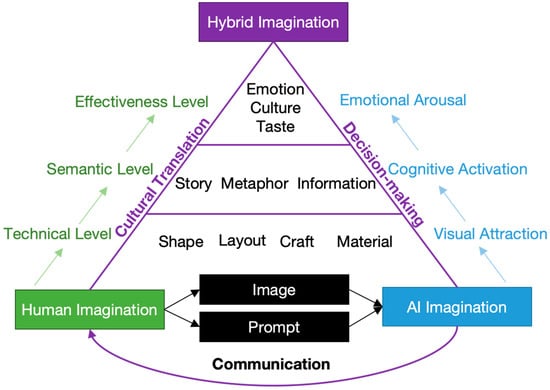
Figure 9.
The hybrid imagination model of human–AI co-creation on culture translation in jewelry design.
One of the limitations of this study is that participants are student designers with relatively limited design experience. Experience is an important factor influencing human–computer interaction; thus, this limitation may affect the study outcomes. For future research, more senior designers could be invited to participate in experiments to expand the diversity of samples. Although the Chinese style is used as a compass for two design actions, the first one is bound to have a potential impact on the second outcome. In future research, therefore, more routes can be used in the experiment to compare the advantages and disadvantages of AI tools in aid of human creative design. Moreover, the changes and invariance in cultural transfer in AI embedding in different product design processes will also be further explored.
Author Contributions
Conceptualization, Y.L. and M.S.; methodology, Y.L.; software, Y.Z.; validation, Y.Z., Y.L. and R.L.; formal analysis, Y.L.; investigation, M.S.; resources, M.S.; data curation, Y.L.; writing—original draft preparation, Y.L.; writing—review and editing, Y.Z. and R.L.; visualization, Y.L.; supervision, R.L.; project administration, M.S. All authors have read and agreed to the published version of the manuscript.
Funding
This research was funded by Beijing Municipal Education Commission, NO. SM202110011005; and a grant from Graduate School of Beijing Technology and Business University.
Institutional Review Board Statement
The study was approved by the Institutional Review Board of Louisiana State University.
Informed Consent Statement
Not applicable.
Data Availability Statement
Data are contained within the article.
Acknowledgments
The authors thank all the designers and experts who provided the images for this study.
Conflicts of Interest
The authors declare no conflict of interest.
Appendix A
Part_01: The questionnaire for self-reporting by student designers
- What do you think is the degree of AI assistance in improving the aesthetic attraction of shape?
- What do you think is the degree of AI assistance in improving the aesthetic attraction of craft?
- What do you think is the degree of AI assistance in improving the aesthetic attraction of materials?
- What do you think is the degree of AI assistance in improving the meaning connection of shape? (like metaphor and story)
- What do you think is the degree of AI assistance in improving the meaning connection of craft? (like metaphor and story)
- What do you think is the degree of AI assistance in improving the meaning connection of materials (like metaphor and story)
- What do you think is the degree of AI assistance in improving the emotional touch of the shape? (like cultural taste and creativity)
- What do you think is the degree of AI assistance in improving the emotional touch of the craft? (like cultural taste and creativity)
- What do you think is the degree of AI assistance in improving the emotional touch of the materials? (like cultural taste and creativity)
Part_02: The questions for the interview with student designers
- What are the advantages of using AI to assist in improving the attraction of shape? What are the limitations?
- What are the advantages of using AI to assist in improving the attraction of craft? What are the limitations?
- What are the advantages of using AI to assist in improving the attraction of materials? What are the limitations?
- What are the advantages of using AI to assist in improving the meaning connection of shape? What are the limitations?
- What are the advantages of using AI to assist in improving the meaning connection of craft? What are the limitations?
- What are the advantages of using AI to assist in improving the meaning connection of materials? What are the limitations?
- What are the advantages of using AI to assist in improving the emotional touch of shape? What are the limitations?
- What are the advantages of using AI to assist in improving the emotional touch of craft? What are the limitations?
- What are the advantages of using AI to assist in improving the emotional touch of materials? What are the limitations?
Part_03: The questions for evaluation by experts
- What degree of technical presentation for Chinese culture do you think this jewelry design has?
- What degree of meaningful connection with Chinese culture do you think this jewelry design has?
- What degree of emotional touch to Chinese culture do you think the shape of this jewelry design has?
References
- Hwang, A.H.-C. Too late to be creative? AI-empowered tools in creative processes. In Proceedings of the CHI Conference on Human Factors in Computing Systems Extended Abstracts, New Orleans, LA, USA, 29 April 2022; pp. 1–9. [Google Scholar]
- Midjourney. Available online: www.midjourney.com (accessed on 25 April 2023).
- Rombach, R.; Blattmann, A.; Lorenz, D.; Esser, P.; Ommer, B. High-resolution image synthesis with latent diffusion models. In Proceedings of the IEEE/CVF Conference on Computer Vision and Pattern Recognition, New Orleans, LA, USA, 19–24 June 2022; pp. 10684–10695. [Google Scholar]
- Ramesh, A.; Dhariwal, P.; Nichol, A.; Chu, C.; Chen, M. Hierarchical text-conditional image generation with clip latents. arXiv 2022, arXiv:2204.06125. [Google Scholar]
- Deep Dream Generator. Available online: https://deepdreamgenerator.com/ (accessed on 25 April 2023).
- Eapen, T.T.; Finkenstadt, D.J.; Folk, J.; Venkataswamy, L. How Generative AI Can Augment Human Creativity. Harv. Bus. Rev. 2023, 101, 55–64. [Google Scholar]
- Liao, Q.V.; Subramonyam, H.; Wang, J.; Wortman Vaughan, J. Designerly understanding: Information needs for model transparency to support design ideation for AI-powered user experience. In Proceedings of the 2023 CHI Conference on Human Factors in Computing Systems, Hamburg, Germany, 23 April 2023; pp. 1–21. [Google Scholar]
- Yu, Q.; Meng, K.; Guo, J. Research on innovative application of silver material in modern jewelry design. MATEC Web Conf. 2018, 176, 02013. [Google Scholar] [CrossRef]
- Lucas, A.; Chapin, M.; Lin, M.; Jia, X. The Chinese Soul in Contemporary Jewelry Design. Gems Gemol. 2015, 51, 18–30. [Google Scholar] [CrossRef]
- Yuan, X. Principle of Design to Follow Nature’s Course. Take Jewelry Design as an Example. In Proceedings of the 3rd International Conference on Arts, Design and Contemporary Education (ICADCE 2017), Moscow, Russia, 30 May 2017; pp. 504–507. [Google Scholar]
- Macagnan, C.B.; Seibert, R.M. Culture: A Pillar of Organizational Sustainability. In Ecotheology-Sustainability and Religions of the World; IntechOpen: London, UK, 2022. [Google Scholar]
- Zhao, C. Strategies for promoting the value of tourist cultural and creative brands based on cultural elements. E3S Web Conf. 2021, 251, 03028. [Google Scholar] [CrossRef]
- Moalosi, R.; Setlhatlhanyo, K.N.; Sealetsa, O.J. Cultural Memory, an Asset for Design-Driven Innovation within the Creative Industries Sector: Lessons for Design Education. Des. Technol. Educ. 2016, 21, 9–22. [Google Scholar]
- Zhu, Q.; Luo, J. Generative transformers for design concept generation. J. Comput. Inf. Sci. Eng. 2023, 23, 041003. [Google Scholar] [CrossRef]
- Goldschmidt, G.; Smolkov, M. Variances in the impact of visual stimuli on design problem solving performance. Des. Stud. 2006, 27, 549–569. [Google Scholar] [CrossRef]
- Viswanathan, V.; Tomko, M.; Linsey, J. A study on the effects of example familiarity and modality on design fixation. AI EDAM 2016, 30, 171–184. [Google Scholar] [CrossRef]
- Jovanovic, M.; Campbell, M. Generative artificial intelligence: Trends and prospects. Computer 2022, 55, 107–112. [Google Scholar] [CrossRef]
- Muller, M.; Chilton, L.B.; Kantosalo, A.; Martin, C.P.; Walsh, G. GenAICHI: Generative AI and HCI. In Proceedings of the CHI Conference on Human Factors in Computing Systems Extended Abstracts, New Orleans, LA, USA, 30 April 2022; pp. 1–7. [Google Scholar]
- Quan, S.J.; Park, J.; Economou, A.; Lee, S. Artificial intelligence-aided design: Smart design for sustainable city development. Environ. Plan. B Urban Anal. City Sci. 2019, 46, 1581–1599. [Google Scholar] [CrossRef]
- Hunde, B.R.; Woldeyohannes, A.D. Future prospects of computer-aided design (CAD)–A review from the perspective of artificial intelligence (AI), extended reality, and 3D printing. Results Eng. 2022, 14, 100478. [Google Scholar] [CrossRef]
- Lyu, Y.; Wang, X.; Lin, R.; Wu, J. Communication in human–AI co-creation: Perceptual analysis of paintings generated by text-to-image system. Appl. Sci. 2022, 12, 11312. [Google Scholar] [CrossRef]
- Song, B.; Soria Zurita, N.F.; Nolte, H.; Singh, H.; Cagan, J.; McComb, C. When faced with increasing complexity: The effectiveness of artificial intelligence assistance for drone design. J. Mech. Des. 2022, 144, 021701. [Google Scholar] [CrossRef]
- Zhou, C.; Li, Y.; Wu, C.; Shao, Y.; Zhou, Y. Study of cognitive activity in AI-augmented design iteration support. In Proceedings of the 2021 14th International Symposium on Computational Intelligence and Design (ISCID), Hangzhou, China, 11 December 2020; pp. 78–82. [Google Scholar]
- Fatma, N.; Haleem, A.; Bahl, S.; Javaid, M. Prospects of jewelry designing and production by additive manufacturing. In Proceedings of the Current Advances in Mechanical Engineering: Select Proceedings of ICRAMERD 2020, Bhubaneswar, India, 24 July 2020; pp. 869–879. [Google Scholar]
- Katz, B.M. Review essay: Technology and design—A new agenda. Technol. Cult. 1997, 38, 452–466. [Google Scholar] [CrossRef]
- Parsons, J.L.; Campbell, J. Digital apparel design process: Placing a new technology into a framework for the creative design process. Cloth. Text. Res. J. 2004, 22, 88–98. [Google Scholar] [CrossRef]
- Cross, N. Human and Machine Roles in Computer-Aided Design; University of Manchester Institute of Science and Technology: Manchester, UK, 1974. [Google Scholar]
- Cross, N. Can a machine design? Des. Issues 2001, 17, 44–50. [Google Scholar] [CrossRef]
- Audry, S. Art in the Age of Machine Learning; Mit Press: Cambridge, MA, USA, 2021. [Google Scholar]
- Stolterman, E. The nature of design practice and implications for interaction design research. Int. J. Des. 2008, 2, 55–65. [Google Scholar]
- Cross, N. Designerly Ways of Knowing: Design Discipline Versus Design Science. Des. Issues 2001, 17, 49–55. [Google Scholar] [CrossRef]
- Moggridge, B.; Atkinson, B. Designing Interactions; MIT Press Cambridge: Cambridge, MA, USA, 2007; Volume 17. [Google Scholar]
- Stoimenova, N.; Price, R. Exploring the nuances of designing (with/for) artificial intelligence. Des. Issues 2020, 36, 45–55. [Google Scholar] [CrossRef]
- Lee, J.H.; Ostwald, M.J. Creative decision-making processes in parametric design. Buildings 2020, 10, 242. [Google Scholar] [CrossRef]
- Koskinen, I.; Zimmerman, J.; Binder, T.; Redstrom, J.; Wensveen, S. Design research through practice: From the lab, field, and showroom. IEEE Trans. Prof. Commun. 2013, 56, 262–263. [Google Scholar] [CrossRef]
- Chi, L. Introduction: Design as Research. J. Archit. Educ. 2001, 54, 250. [Google Scholar] [CrossRef]
- Pasricha, A.; Greeninger, R. Exploration of 3D printing to create zero-waste sustainable fashion notions and jewelry. Fash. Text. 2018, 5, 1–18. [Google Scholar] [CrossRef]
- Garner, S.; McDonagh-Philp, D. Problem interpretation and resolution via visual stimuli: The use of ‘mood boards’ in design education. J. Art Des. Educ. 2001, 20, 57–64. [Google Scholar] [CrossRef]
- Adams, R.S.; Atman, C.J. Cognitive processes in iterative design behavior. In Proceedings of the FIE’99 Frontiers in Education, 29th Annual Frontiers in Education Conference. Designing the Future of Science and Engineering Education, San Juan, PR, USA, 13 November 1999; Volume 11, pp. 11A16/13–11A16/18. [Google Scholar]
- Hybs, I.; Gero, J.S. An evolutionary process model of design. Des. Stud. 1992, 13, 273–290. [Google Scholar] [CrossRef]
- Adams, R.S. Cognitive Processes in Iterative Design Behavior; University of Washington: Seattle, WA, USA, 2001. [Google Scholar]
- Hartley, J. Communication, Cultural and Media Studies: The Key Concepts; Routledge: Abingdon, UK, 2019. [Google Scholar]
- Lin, R.-T. Transforming Taiwan aboriginal cultural features into modern product design: A case study of a cross-cultural product design model. Int. J. Des. 2007, 1, 45–53. [Google Scholar]
- Hsueh, S.-L.; Zhou, B.; Chen, Y.-L.; Yan, M.-R. Supporting technology-enabled design education and practices by DFuzzy decision model: Applications of cultural and creative product design. Int. J. Technol. Des. Educ. 2022, 32, 2239–2256. [Google Scholar] [CrossRef]
- Sun, X.; Jin, W.; Li, C. Research on the design of Nanjing museum cultural and creative product from the perspective of experience. In Proceedings of the Design, User Experience, and Usability: Understanding Users and Contexts: 6th International Conference, DUXU 2017, Held as Part of HCI International 2017, Vancouver, BC, Canada, 9–14 July 2017; Part III 6. pp. 529–539. [Google Scholar]
- Lee, K.-P. Design Methods for Cross-Cultural Collaborative Design Project. In Proceedings of the Futureground—DRS International Conference 2004, Melbourne, Australia, 17 November 2004. [Google Scholar]
- Wu, J.; Ju, L.-H.; Lin, P.-H.; Lyu, Y. The Relationship between Form and Ritual in Cultural Sustainability. Sustainability 2022, 14, 9157. [Google Scholar] [CrossRef]
- Hsu, C.-H.; Lin, C.-L.; Lin, R. A study of framework and process development for cultural product design. In Proceedings of the Internationalization, Design and Global Development: 4th International Conference, IDGD 2011, Held as Part of HCI International 2011, Orlando, FL, USA, 9–14 July 2011; pp. 55–64. [Google Scholar]
- Gong, B.-H.; Yuan, R. Study of Contemporary Jewelry Design Emotional Expression Skills. J. Arts Humanit. 2017, 6, 57–61. [Google Scholar] [CrossRef][Green Version]
- Shi, M.; Zhang, C.; Ting, Y.; Lin, P.-H. Application of Auspicious Cultural in Metalworking Jewelry Design. In Proceedings of the Cross-Cultural Design, Applications in Health, Learning, Communication, and Creativity: 12th International Conference, CCD 2020, Held as Part of the 22nd HCI International Conference, HCII 2020, Copenhagen, Denmark, 19–24 July 2020; pp. 548–558. [Google Scholar]
Disclaimer/Publisher’s Note: The statements, opinions and data contained in all publications are solely those of the individual author(s) and contributor(s) and not of MDPI and/or the editor(s). MDPI and/or the editor(s) disclaim responsibility for any injury to people or property resulting from any ideas, methods, instructions or products referred to in the content. |
© 2023 by the authors. Licensee MDPI, Basel, Switzerland. This article is an open access article distributed under the terms and conditions of the Creative Commons Attribution (CC BY) license (https://creativecommons.org/licenses/by/4.0/).





